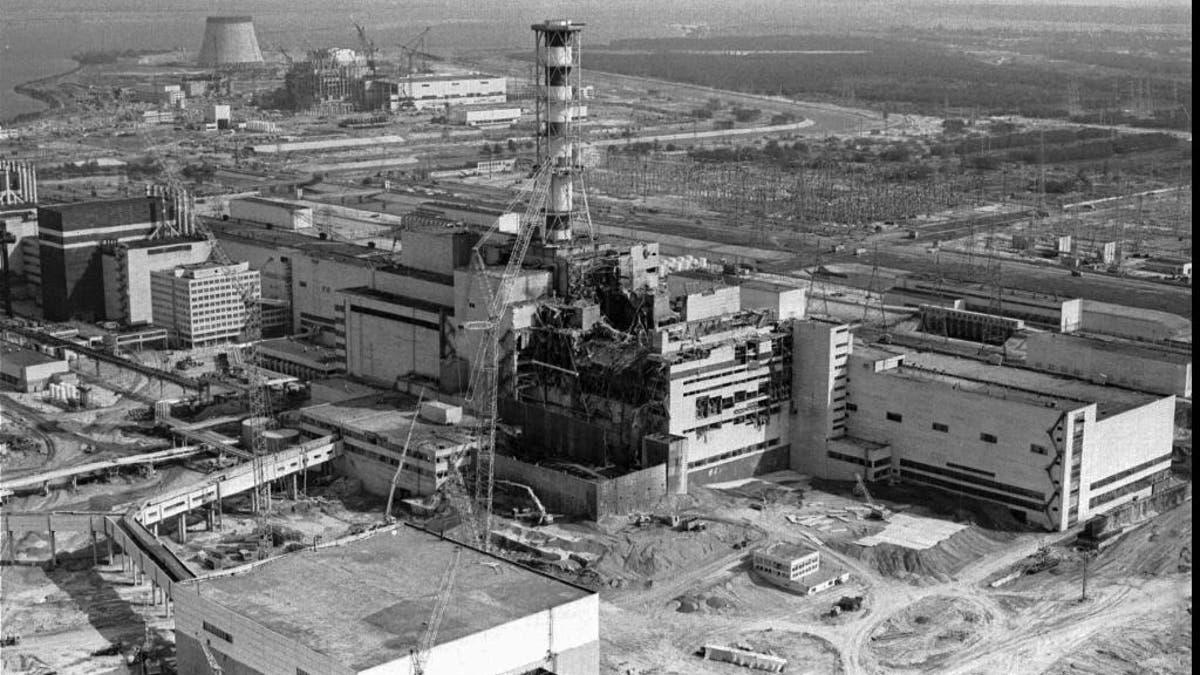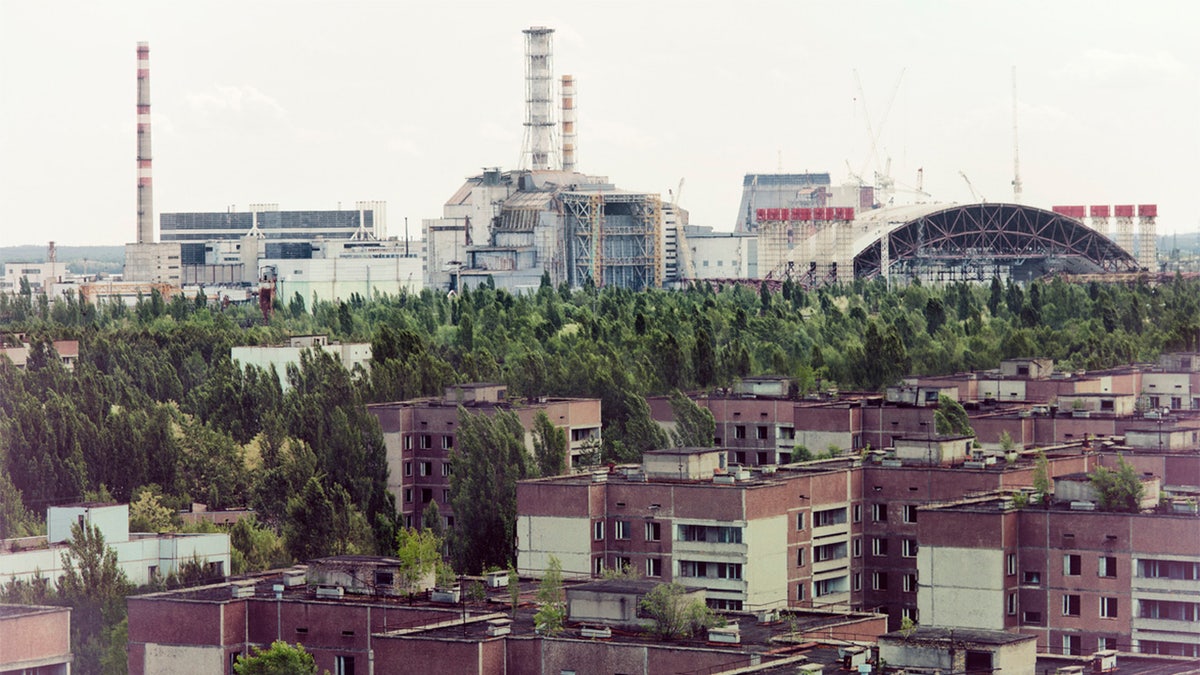Get all the latest news on coronavirus and more delivered daily to your inbox. Sign up here.
Last week in the midst of the coronavirus crisis, Ukrainians commemorated the 34th anniversary of another catastrophe --- the explosion at the Chernobyl nuclear power plant, the world’s worst nuclear accident.
Wearing face masks to protect themselves against what the U.S. president calls the “invisible enemy,” the deadly coronavirus, workers at Chernobyl lit candles in memory of those killed at the plant 34 years ago by their own “invisible enemy” – the 100 radioactive elements that spewed into the air on that fateful night, April 26, 1986, when Reactor #4 melted down and contaminated over 58,000 square miles of Ukraine, Belarus, and Russia.

A 1986 file photo of an aerial view of the Chernobyl nuclear plant in Chernobyl, Ukraine showing damage from an explosion and fire in reactor four. (AP/File)
The accident was the result of a flawed reactor design, Soviet cost-cutting, shoddy construction, corruption, and a culture of secrecy. When the Soviet Union collapsed and Ukraine became independent in 1991, its government banned visitors from two “exclusion” zones around the plant, the larger of which is roughly the size of Rhode Island. But in 2011, the government decided to encourage tourism to 75 percent of the zone deemed to be safe.
LIMITED TIME OFFER, GET YOUR FIRST MONTH OF FOX NATION FOR $0.99
Last September, I visited Chernobyl with a small production team for Fox Nation soon after HBO aired a mini-series about the accident that was seen by millions of people throughout the world.
What we saw at Chernobyl still haunts me, just as the accident itself continues to haunt Ukraine.
Would the HBO docudrama spark renewed interest in, and visits to the devastated, dangerous site? As a journalist, I had already visited many Soviet-era nuclear and germ weapons facilities and our own still partly contaminated Nevada Test Site, just 65 miles north of Las Vegas where the U.S. tested over a thousand atomic bombs in the 1950s.
But what we saw at Chernobyl still haunts me, just as the accident itself continues to haunt Ukraine. And now you can visit this “nuclear Pompei” along with me – virtually – by watching our documentary on "Destination Chernobyl" Fox Nation.
You can meet Serhii Plokhy, the author of a groundbreaking book on the accident who worries about the lessons of Chernobyl and nuclear power that we’re not learning.
You can see the nuclear ghost town of Pripyat, the Soviet “atomic city” 10 minutes from the plant where 50,000 workers and their families lived before the accident.
You can walk on the now overgrown soccer field where children once played, see the faded algebra book, covered in radioactive dust on a decrepit school floor, the ragged, smiling doll on a tiny bed in an abandoned apartment building, the giant Ferris wheel in the town’s amusement park, frozen for eternity.

Chernobyl nuclear power station and Pripyat
Almost 1,000 dogs, offspring of those abandoned when the Soviets evacuated the city – 36 hours after the accident – roam the town and its surroundings. They are not friendly. Scientists say they live an average of only four years.
More from Opinion
The forests seem green and lush, filled with deer, moose, wolves, eagles, and horses imported from Mongolia. But that, too, is deceptive, Plokhy says. There are no spider webs in these forests. The soil remains too contaminated.
CLICK HERE TO GET THE OPINION NEWSLETTER
So in April, when wildfires – naturally or deliberately set is still uncertain – swept through over 8,600 acres of birch trees and approached the nuclear plant, scientists feared that dust from the radioactive soil might endanger the three-million people in the Ukrainian capital of Kyiv, 60 miles away. But the fires were contained, and only a few of the Soviet era-tourist attractions destroyed.
10 INTERESTING FACTS ABOUT THE CHERNOBYL NUCLEAR DISASTER
On my tour, I took along a dosimeter to measure my exposure to various radioactive isotopes, a few of which can last 25,000 years. Having an official guide ensured that the crew and I would not linger too long in contaminated areas. But many young Ukrainians, unable or unwilling to pay the roughly $100-a-person fee that tour companies charge, delight in sneaking into the zone on their own. Many of these so-called “stalkers” also carry dosimeters. Watch one of them call being in the zone illegally a truly “psychedelic experience.”
Because coronavirus prompted Ukraine to close its borders in mid-March, there are now no tourists here. But Sergii Mirnyi, the head of Chernobyl Tours, has ambitious plans once the zone reopens: kayaking on the Dnieper River along the disabled plant and it's giant “sarcophagus” – the world’s largest moveable steel structure that covers the tons of radioactive rubble from Reactor #4 – and a 5-day “spa” vacation. “Very restful,” he tells us.

A wild boar runs in the exclusion zone around the Chernobyl nuclear reactor near the village of Babchin, some 217 miles southeast of Minsk, January 9, 2009. (REUTERS/Vasily Fedosenko)
The government, too, wants to encourage tourism here. In July, President Volodymyr Zelensky, 42, a former comedian, screenwriter, film producer and director who was elected in the spring of 2019 with over 73 percent of the vote, signed a decree encouraging Chernobyl tourism. Calling it a “unique” site, he said that he wants to give this desolate part of Ukraine “new life.”
The Exclusion Zone Management Agency, responsible for protecting the plant’s critical infrastructure, has other ideas. One official tells us the agency intends to store nuclear waste here in the zone, and not just from Ukraine’s 15 nuclear reactors that continue to provide most of the country’s electricity, but waste from other European nuclear reactors as well.
SEE MORE OF JUDITH MILLER'S WORK ON FOX NATION
Plokhy calls this a terrible idea. Although it would seemingly make sense to store nuclear waste at a site already so contaminated, the area is composed not of stable, hard rock that can contain radioactive material for hundreds of years, he tells us, but unstable, highly-porous marshland.
But even he thinks that people should visit Chernobyl if only to understand the potential danger of nuclear power in incompetent or malicious hands. The accident itself still weighs heavily on Ukraine, which continues to pay compensation to the families of at least 35,000 people who died of Chernobyl-related cancers.
CLICK HERE TO GET THE FOX NEWS APP
There are valuable lessons to be learned from what Adam Higginbotham, the author of “Midnight at Chernobyl,” another powerful book on the disaster, calls this “radioactive Eden.”
But as my crew and I left Chernobyl, I wondered whether we would ever learn them. Watch Fox Nation's "Destination Chernobyl," and decide that for yourself.
To watch all of "Destination Chernobyl," including Miller's interviews with Ukrainians, who lived through the disaster, go to Fox Nation and sign up today.
LIMITED TIME OFFER, GET YOUR FIRST MONTH OF FOX NATION FOR $0.99
Fox Nation programs are viewable on-demand and from your mobile device app, but available only for Fox Nation subscribers. Go to Fox Nation to start a free trial and watch the extensive library from Tomi Lahren, Pete Hegseth, Abby Hornacek, Laura Ingraham, Greg Gutfeld, Judge Andrew Napolitano and many more of your favorite Fox News personalities.

